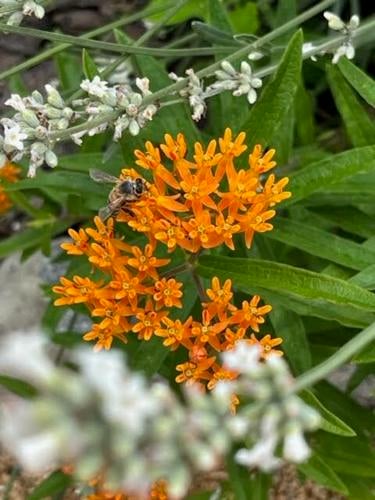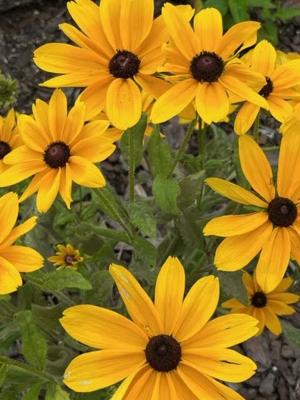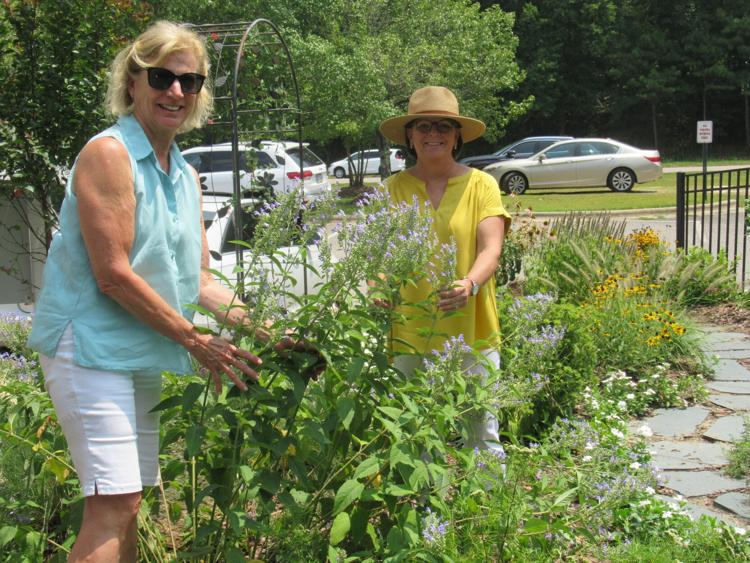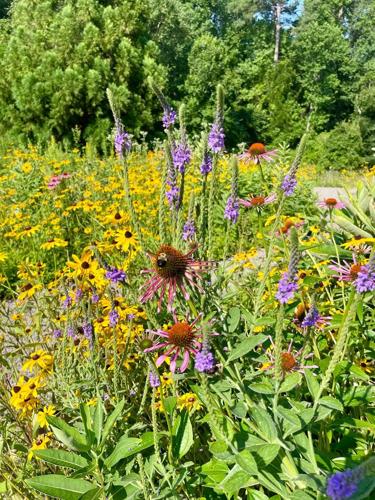BY LAURA DOUGLASS Features Editor Aug 4, 2023
The Native Pollinator Garden is located on the hillside along Magnolia Road just south of Joyce’s Meadow, in the Village Arboretum in Pinehurst.
LESLEY BERKSHIRE-BRADLEY Special to The Pilot
The beloved children’s book heroine Miss Rumphias wanted three things in life: to travel, to live by the sea, and to leave the world a better place. As told by Barbara Cooney, the story was inspired by the real life Lupine Lady, Hilda Hamlin, who scattered lupine seeds along the Maine coast near her home — forever dotting those hills and harbors with brightly colored flowers.
Volunteers with ties to the Arboretum Native Pollinator Garden, in Pinehurst, have likewise taken to spreading beauty by sharing the seeds of native pollinator plants to their own home gardens and public gardens throughout the county. Located in the Village Arboretum and completed in 2020, the 10,000-square-foot Native Pollinator Garden was designed to attract all kinds of pollinators — butterflies, moths, beetles, bats, bees and birds — thus playing a critical role in their conservation as well.
“This ‘web of plant sharing’ is creating a Moore County pollinator highway. We are leaving the world a better place, one plant at a time, just like Miss Rumphias,” says Lesley Berkshire Bradley, a longtime board member of the Village Heritage Foundation, the nonprofit that built the Village Arboretum.
In recent years, plants and seeds from the Native Pollinator Garden have started or added to the Books and Bees Garden at the Southern Pines Public Library, the Jones Park Garden in Whispering Pines, the Pinewild Community Garden, the Flagship Garden in front of the Moore County Agricultural Center in Carthage, and Therapeutic Garden at the Moore County Senior Enrichment Center, among many others.

Honeybee on a butterfly weed plant
ALICE ROMANS-HESS Special to The Pilot
The late Joyce Franke founded the Village Heritage Foundation in 1992, to raise money to restore the Fair Barn. When that work was finished, she set her mind to creating the Village Arboretum. Her daughter, Beth Franke Stevens, a former head of Disney’s Animal Kingdom, now serves as president of the foundation.
“The original vision for the Arboretum did not call out a pollinator garden, but a garden for native species. Pollinators are in decline, and we wanted to showcase these plants and encourage people to start their own native pollinator gardens at home,” says Stevens. “A key part of our thinking was this would be a great educational opportunity. In the garden pavilion we have signs with beautiful graphics and photos, so people can see the names of the plants, and we also put signs out to identify the plants.”

Rudbeckia in bloom
ALICE ROMANS-HESS Special to The Pilot
Exotic flowers in a garden may be pretty, but native plants to the Sandhills — which deer don’t typically like — attract native pollinators and provide them with shelter and food.
“If everyone planted native plants, we are providing a native habitat for all kinds of pollinators. I mean, wouldn’t it be spectacular if all the homes in Pinehurst, Aberdeen and Southern Pines had pollinator plants? We would be this really rich place,” she adds, “attracting these pollinators.”
A few miles north of the Pinehurst Traffic Circle, the Therapeutic Garden hums with activity, literally, as dozens of honeybees take flight among the late summer blooms.
Master Gardeners Betty Dew and Paula Parke took over this little corner in front of the county’s Senior Enrichment Center in late 2021, and began to turn the garden into a restorative oasis in partnership with the NC State Cooperative Extension and Moore County Cooperative Extension offices.

Master Gardeners Paula Parke, at left, and Betty Dew tend to native pollinator plants in the Therapeutic Garden at the Moore County Senior Enrichment Center, in West End
LAURA DOUGLASS / The Pilot
At only 700 square feet, it is a tiny showplace of different colors, shapes and sizes of plants. A nearby sign notes the garden is meant to stimulate the senses to promote mental tranquillity, provide stress reduction, encourage emotional recovery and increase individual energy. Here you’ll find ornamental grasses, a trellis and comfortable bench for seating, and oodles of foliage — from spiderwort to black-eyed Susans, and Nodding onion — cultivated from plants shared from the Native Pollinator Garden.
Dew, who has lived in Moore County since the mid-1970s, completed the Master Gardener program in 2016. Parke completed the comprehensive program in 2015. Their work at the Therapeutic Garden is a way to give back to the community.
“My mother always gardened around the house. She had a green thumb, and I guess I inherited that from her, and a love of being outdoors,” says Parke. “Demonstration gardens are wonderful for public education, but we wanted to expand to something more that the clients of the Senior Enrichment Center could benefit from. We wanted to engage them more, allow them to participate more and take some of the benefits of gardening.”
Dew agrees. “We have seen it ourselves that people will come and sit on the bench here. Or people will see us in the garden and ask about the plants.”
The two friends hope to expand their restorative garden outreach by offering talks at the Senior Enrichment Center and serving tea using plants plucked from the Therapeutic Garden.
“We are proud of the variety in the garden. For the most part, there is always something to look and and enjoy all year. Even the daphnes, which have a really sweet smell and bloom in winter, that is their time to shine.”
And it’s not just the plants that thrive as a result of the attentive care of these volunteers.
The “web of plant sharing” has also encouraged a sense of unity and purpose, and underpinned new friendships and acquaintances. Dew notes there are over 100 volunteers involved in the Master Gardener program, in addition to the area’s many active gardening clubs.
“We share plants and we build friendships,” she says.
To view a list of native pollinator plants, visit villageheritagefoundation.org/projects/native-pollinator-garden.


